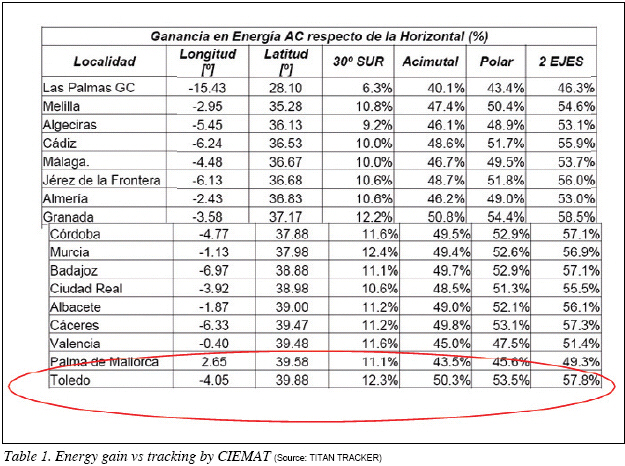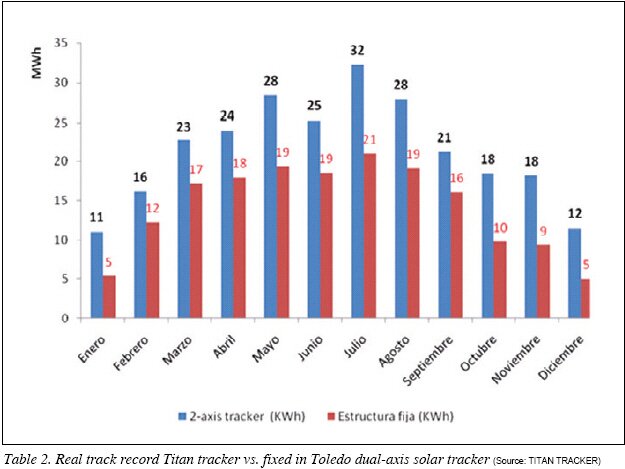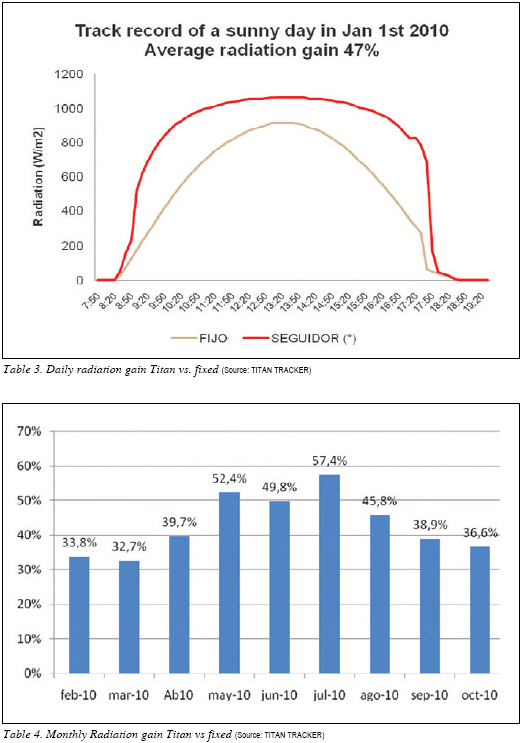By Carlos Garcia
.jpg)
Advantages of the Solar Trackers
.jpg) Conventional PV has a great penetration in the market because of its maturity. There are different technologies (mono, poli, thin film, etc.) both tracked and fixed systems. Most of the utility scale solar projects are fixed structures. Conventional PV has a great penetration in the market because of its maturity. There are different technologies (mono, poli, thin film, etc.) both tracked and fixed systems. Most of the utility scale solar projects are fixed structures.
However, the solar tracking has positive impact in the overall performance of the PV systems because of the following reasons:
-Less losses due to dust and dirt. The movement in the solar trackers reduces deposition of the dust and dirt in the PV modules. Uniform dirt results in a decrease of the current and voltage and located dirt (as bird droppings) leads to an increasing mismatch losses and hot dots.
-Less angular losses. If solar radiation is not perpendicular to the surface of the PV modules implies additional losses (reflectivity and so on) which less to additional losses which are increased with degree of dust and dirt. Solar trackers with complete 2-axis range such as Titan tacker do not have angular losses.
-Less temperature losses. PV modules have a power loss about 4%/10¡É increase in operating temperature depending on each technology. The operating temperature of PV modules depends on factors environmental irradiance, ambient temperature and wind speed and position of the modules or the back ventilation. Solar trackers makes better ventilation and hence less temperature losses.
-Less performance losses AC/DC inverter. The yield curve of the inverter is a function of operating power. Solar trackers lead to operation of the inverter close to the optimum power in high values yield so these losses are minimal.
There is only one drawback in the one side. Dual-axis tracking with a complete elevation range requires more land. This is a trade-off between the cost of land and price of energy you get. We assume utility scale solar parks are located where availability and cost of land is not a relevant drawback. Therefore, financial models are much more sensitive to extra annual cash flow than extra land.
The energy output provided by specific solar tracker is usually justified in technical due diligence reports by means of:
-Real track record of energy gain,
-Real track record of radiation gain,
-Simulation by different software tools,
-Several previous theoretical analysis.
There are different software tools in the market in order to simulate the energy yield: PVSYST, PVGIS, PVSOL...being PVSYST the most used in Europe so far. However, there are some limitations in the software since it never provides real conditions because of complex issues affecting solar trackers such as diffuse, reflection...
On the other hand, there are different theoretical studies carried out by quite well-known R&D institutions in which it has been analyzed energy yield by using a complete dual-axis solar tracking system. Just for reference, Ph.D. Mr. Miguel Alonso Abella and Ph.D. Mr. Faustino Chenlo from PV Labs CIEMAT, a Spanish R&D institution (www.ciemat.es), describes that energy yield using complete 2-axis is about 45% more than fixed systems in Toledo, Spain (see Table 1).
However, the content of this technical paper is focused on the real track record both energy output and radiation. This document outlines real track record of energy yield and radiation gain of a dual-axis tracker in the market.
Energy Yield Gain
The energy yield of the solar tracker can be determined by means on several factors such as type of tracking, range of tracking and obviously overall reliability.
Just for reference, the real gain of energy yield with a complete dual-axis tracker is up to 45% more than fixed systems in 30¡Æ tilt oriented to the South, 40¡Æ North latitude (Spain) since it starts from 10¡Æ in elevation as Titan tracker.
Most of the mounted pole dual axis tracking systems do not have a complete dual axis tracking since start from 30/35¡Æ in elevation range. Please note the sun keeps under 35¡Æ during 98 days in Spain.
As an example, it is included in the figure 2 for a real ¡®track record¡¯ of the energy yield in terms of KWh/KWp of two solar installations of 100 KW AC, one of them using fixed system (30¡Æ tilt and oriented to the South) and the other, using Titan trackers, both located in the province of Toledo, Spain in the same period of time, from October, 2008 to September 2009.
If we compare the annual energy output in the same location:
-Titan Trackers = 2.293 KWh/ KWp (from 1/10/2008 to 1/09/2009)
-Fixed systems = 1.523 KWh/KWp (from 1/10/2008 to 1/09/2009)


Radiation Gain
.jpg) We have been monitoring (monthly and accumulated) radiation gain from February 1st, 2010 measured by means of two calibrated sensors reference Si-01TC model manufactured by the German company IngenIeurburo, Mencke & Tegtmeyer GmbH. One sensor (red line) has been placed in one of our Titan Trackers with complete dual-axis; and the other sensor (brown line), has been placed in a fixed structure 30¡£ tilt to the South in the same solar park (see Table 3). We have been monitoring (monthly and accumulated) radiation gain from February 1st, 2010 measured by means of two calibrated sensors reference Si-01TC model manufactured by the German company IngenIeurburo, Mencke & Tegtmeyer GmbH. One sensor (red line) has been placed in one of our Titan Trackers with complete dual-axis; and the other sensor (brown line), has been placed in a fixed structure 30¡£ tilt to the South in the same solar park (see Table 3).
Please note that this data (radiation sensor placed on the tracker) has been already corrected using the calibration factor which is the error between both radiation sensors, typically the measure error is +/- 5% according to the technical specs.
Table 4 shows the monthly radiation gain on average. It is unusually low radiation gain on average because of unusual radiation levels during June and August where the radiation gain using complete 2-axis tracking is really important (i.e. July 57%)

Generally, there is not any justification to consider that complete dual-axis solar tracking provides less than 35% over fixed systems in 40¡£ North latitude, South of Europe. The real track record and latest results can demonstrate that this assumption is not valid at all. These results by using dual axis solar tracker would not have been possible if this solar tracker had not provided similar reliability as fixed systems. This document outlines real track record of energy yield and radiation gain of one dual-axis tracker with a complete elevation such as Titan tracker. All relevant data were collected from October 2008 to November 2010.
Carlos Garcia is Manager of Sales & Marketing of TITAN TRACKER (www.titantracker.com) since the year 2008. He has also consolidated a solid background in his previous stage in an international consulting firm specialized in business strategy and product innovation during almost 10 years. He graduated with a degree in Electronic Engineering ICAI from University of Comillas and Executive MBA by the IE Business School in Madrid, Spain.
For more information, please send your e-mails to pved@infothe.com.
¨Ï2011 www.interpv.net All rights reserved.
|



